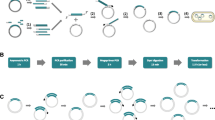Abstract
Narrow-host-range vectors, based on an indigenous replicon and containing a multiple cloning site, have been constructed in aPseudomonas host capable of growth on unusual substrates. The new cloning vectors yield sufficient amounts of DNA for preparative purposes and belong to an incompatibility group different from that of the incP and incQ broad-host-range vectors. One of these vectors, named pDB47F, was used to clone, directly inPseudomonas, DNA fragments fromAgrobacterium, Pseudomonas, andRhizobium. A clone containingAgrobacterium and KmR gene sequences was transformed with a higher efficiency than an RSF1010-derived vector (by as much as 1250-fold) in four out of fivePseudomonas strains tested. The considerable efficiency obtained with this system makes possible the direct cloning and phenotypic selection of foreign DNA inPseudomonas.
Similar content being viewed by others
Literature Cited
An G (1987) Binary Ti vectors for plant transformation and promoter analysis. Methods Enzymol 153:292–305
Ausubel FM, Brent R, Kingston RE, Moore DD, Seidman JG, Smith JA, Struhl K (1987) Current protocols in molecular biology. New York: Wiley & Sons
Bagdasarian M, Lurz R, Rückert B, Franklin FCH, Bagdasarian MM, Frey J, Timmis KN (1981) Specific-purpose plasmid cloning vectors. II. Broad-host-range, high copy number, RSF1010-derived vectors, and a host-vector system for gene cloning inPseudomonas. Gene 16:237–247
Beaulieu C, Gill S, Miville L, Dion P (1988) Genetic regions ofPseudomonas aureofaciens strain 211 involved in nopaline catabolism. Can J Microbiol 34:843–849
Birnboim HC (1983) A rapid alkaline extraction method for the isolation of plasmid DNA. Methods Enzymol 100: 243–255
Boivin R, Bellemare G (1991) A novel approach to the rapid isolation and nucleotide sequencing of genomic clones. Genet Anal 8:181–185
Boivin R, Lebeuf H, Dion P (1987) Octopine and octopinic acid utilization in a nonfluorescentPseudomonas sp.: enhancement by spontaneous mutation and lack of effect from curing of a plasmid. Can J Microbiol 33:534–540
Boivin R, Chalifour F-P, Dion P (1988) Construction of a Tn5 derivative encoding bioluminescence and its introduction inPseudomonas, Agrobacterium andRhizobium. Mol. Gen Genet 213:50–55
Dessaux Y, Tempé J, Farrand SK (1987) Genetic analysis of mannityl opine catabolism in octopine-typeAgrobacterium tumefaciens strain 15955. Mol Gen Genet 208:301–308
Dunn IS (1991)Pseudomonas aeruginosa plasmids as suicide vectors inEscherichia coli: resolution of genomic cointegrates through short regions of homology. Gene 108:109–114
Figurski DH, Helinski DR (1979) Replication of an origin containing derivative of plasmid RK2 dependent on a plasmid function intrans. Proc Natl Acad Sci USA 76:1648–1652
Giraldo R, Nieto C, Fernández-Tresguerres ME, Díaz R (1989) Bacterial zipper. Nature 342:866
Gough JA, Murray NE (1983) Sequence diversity among related genes for recognition of specific targets in DNA molecules. J Mol Biol 166:1–19
Itoh N, Koide Y, Fukuzawa H, Hirose S, Inukai T (1991) Novel plasmid vectors for gene cloning inPseudomonas. J Biochem 110:614–621
Mead DA, Szczesna-Skorupa E, Kemper B (1986) Singlestranded DNA “blue” T7 promoter plasmids: a versatile tandem promoter system for cloning and protein engineering. Protein Eng 1:67–74
Mermod N, Lehrbach PR, Don RH, Timmis KN (1986) Gene cloning and manipulation inPseudomonas. In: Sokatch JR (ed) The bacteria: a treatise on structure and function, vol 10. Orlando, Fl: Academic Press, pp 325–355
Morales V, Bagdasarian MM, Bagdasarian M (1990) Promiscuous plasmids of the IncQ group: mode of replication and use for gene cloning in Gram-negative bacteria. In: Silver S, Chakrabarty AM, Iglewski B, Kaplan S (eds)Pseudomonas. Washington, DC: American Society for Microbiology, pp. 229–241
Nautiyal CS, Dion P, Chilton WS (1991) Mannopine and mannopinic acid as substrates forArthrobacter sp. strain MBA209 andPseudomonas putida NA513. J Bacteriol 173:2833–2841
Nieto C, Fernández-Tresguerres E, Sánchez N, Vicente M, Díaz R (1990) Cloning vectors, derived from a naturally occurring plasmid ofPseudomonas savastanoi, specifically tailored for genetic manipulations inPseudomonas. Gene 87: 145–149
Nieto C, Giraldo R, Fernández-Tresguerres E, Díaz R (1992) Genetic and functional analysis of the basic replicon of pPS10, a plasmid specific forPseudomonas isolated fromPseudomonas syringae pathovar savastanoi. J Mol Biol 223: 415–426
Pemberton JM, Penfold RJ (1992) High-frequency electroporation and maintenance of pUC- and pBR-based cloning vectors inPseudomonas stutzeri. Curr Microbiol 25: 25–29.
Rothmel RK, Chakrabarty AM, Berry A, Darzins A (1991) Genetic systems inPseudomonas. Methods Enzymol 204: 485–514
Sambrook J, Fritsch EF, Maniatis T (1989) Molecular cloing. A laboratory manual. Cold Spring Harbor, N.Y.: Cold Spring Harbor Laboratory Press
Van den Eede G, Deblaere R, Goethals K, Van Montagu M, Holsters M (1992) Broad-host-range and promoter selection vectors for bacteria that interact with plants. Mol Plant-Microbe Interact 5:228–234
Vieira J, Messing J (1982) The pUC plasmids, an M13mp7-derived system for insertion mutagenesis and sequencing with synthetic universal primers. Gene 19:259–268
Author information
Authors and Affiliations
Rights and permissions
About this article
Cite this article
Boivin, R., Bellemare, G. & Dion, P. Novel narrow-host-range vectors for direct cloning of foreign DNA inPseudomonas . Current Microbiology 28, 41–47 (1994). https://doi.org/10.1007/BF01575984
Issue Date:
DOI: https://doi.org/10.1007/BF01575984




